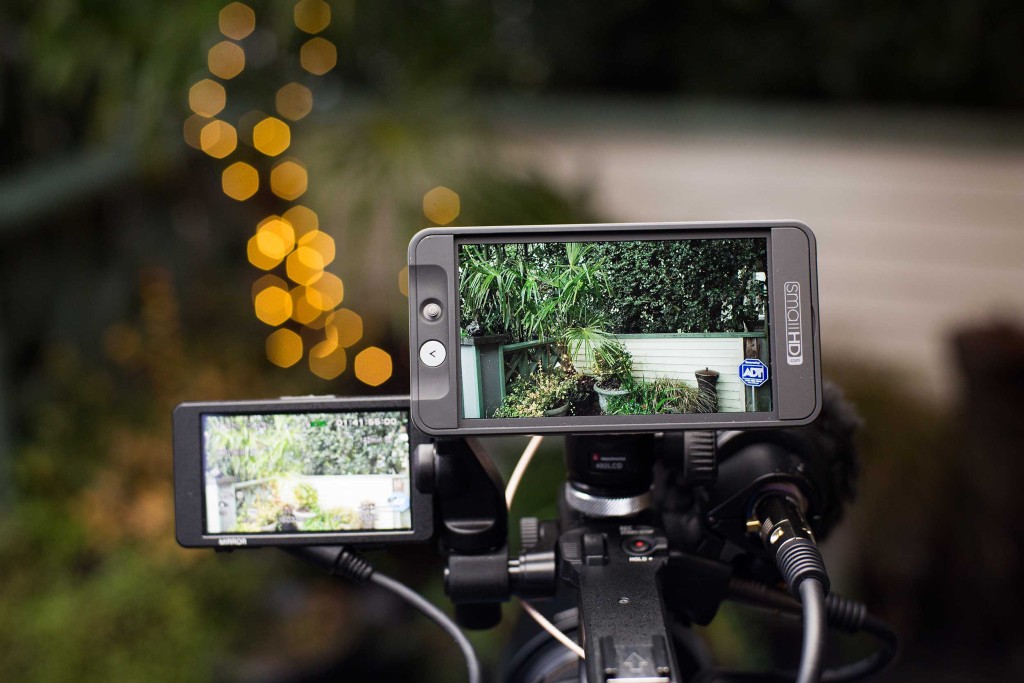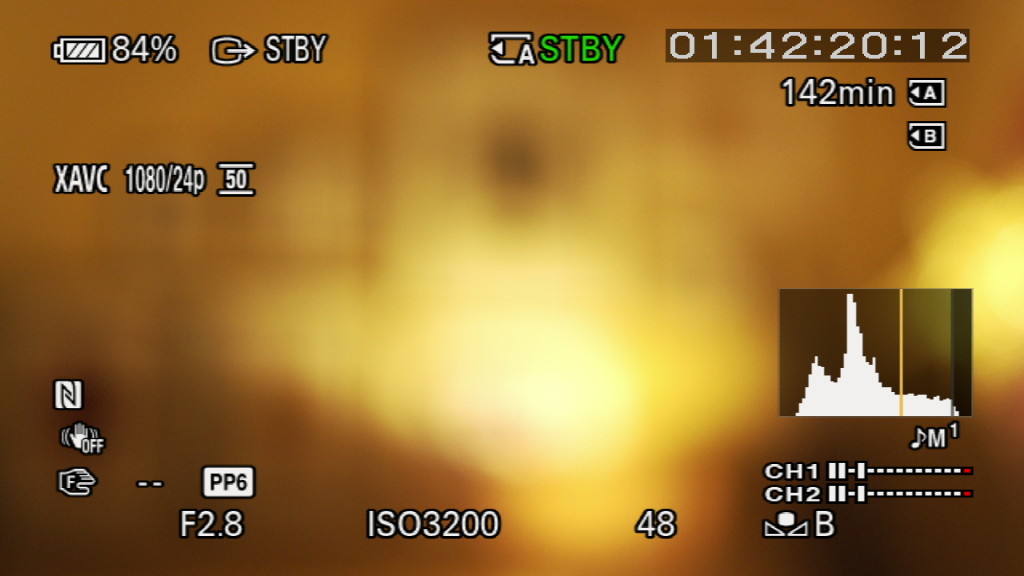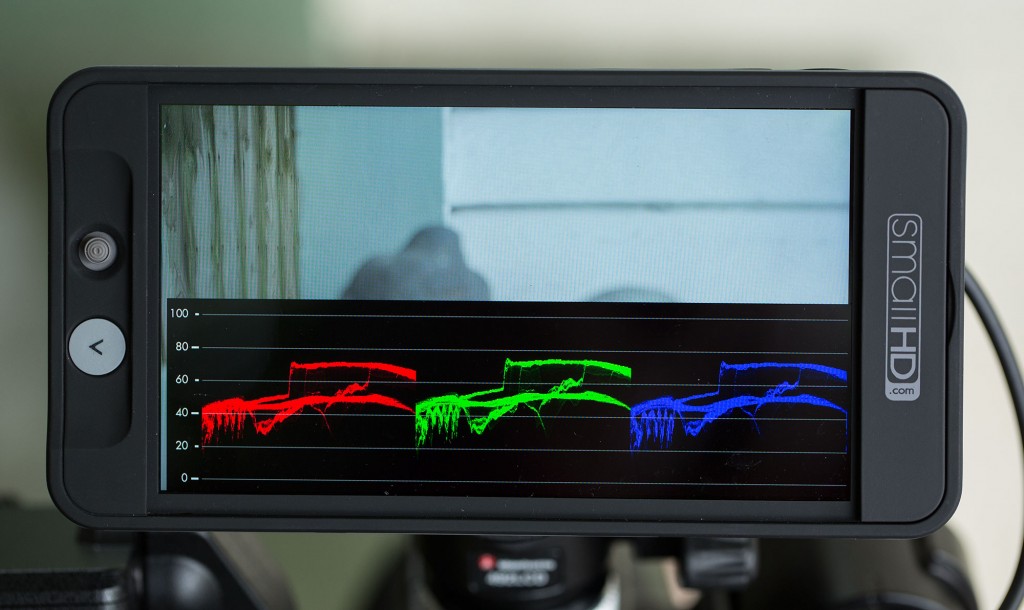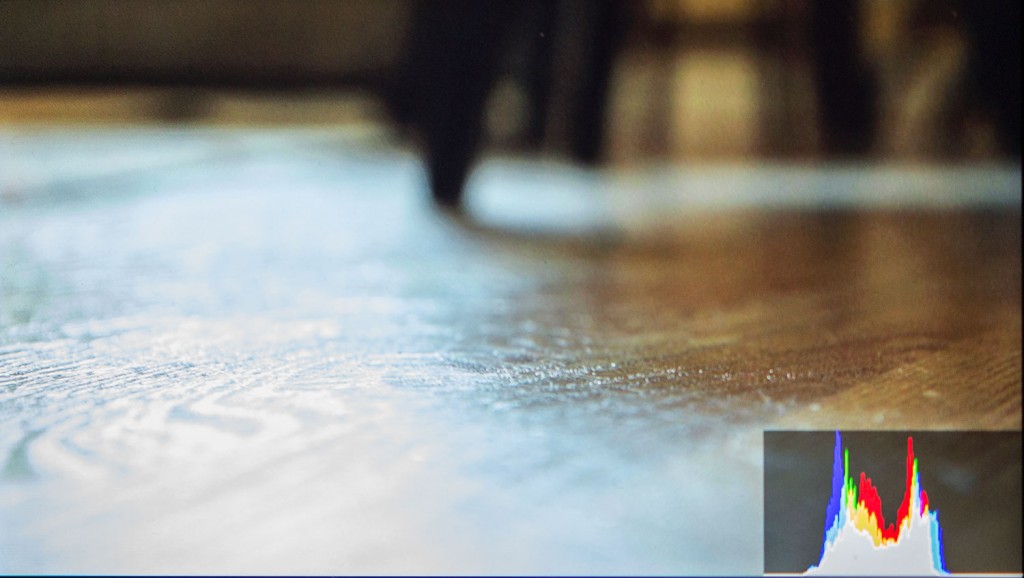
The SmallHD 502 is a monitor that feels like it was made for the Sony FS5, addressing the camera’s fatal monitoring flaw while remaining true to it’s handheld aesthetic.
Sony’s new FS5 is a killer documentary camera. After just three months using the camera on a variety of projects, I’m hopelessly addicted to it’s stepless ND, it’s 14 stops of dynamic range, and it’s hand-hugging ergonomics. But if you want to take advantage of those 14 stops, you have to shoot SLOG. And if you shoot SLOG, you need to overexpose by at least a stop, to kill noise in the shadows. On higher-end Sony cameras like the FS7 and F55, you can load monitor LUTs to compensate for this. But the FS5 doesn’t support monitor LUTs. So overexposing blows out the image, making it difficult gauge exposure on the LCD.
This problem isn’t going to be fixed in firmware, we’re told by Sony. The chip in this camera will never be fast enough to support monitor LUTs. So. What’s a self-respecting documentary DP to do? I went looking for an external monitor that supports LUTs. One that doesn’t disrupt the feng shui of this fit-in-your-hand camera. Here’s what I found.
First the bad news: many of the popular external monitors that support LUTs are too big for the FS5. I’ve used two, the Atomos Ninja Assassin and the Odyssey 7Q+. Perched on the top handle of the FS5, they are about as complementary to the aesthetic of this camera as Donald Trump has been to the presidential ambitions of Jeb Bush.
The whole point of the Sony FS5 is grab and shoot. This camera empowers you to feel your way into a scene, with everything at your fingertips. So bolting a lot of stuff, or turning it into a shoulder mounted beast like it’s bigger brother the FS7 (as Zacuto would love for you to do), just isn’t right. We need to look for an option that respects the form of this camera.
A fellow Seattle DP, Gabriel Miller, recommended I take a look at the SmallHD 502. And after spending a few days shooting with it, I got really excited and bought one. I’ll explain why in a minute.
But first, a few words about my old monitor, which happens to be the SmallHD DP6. I’ve been using it since 2011, and I love this monitor. But recently I’ve observed what seems to be a trend toward larger on-camera monitors. Good-quality LCD and even OLED screens must be getting cheaper to make, because there sure are a lot of them out there. And it seemed to me that having another inch or so of screen would be a very nice thing indeed.
So when SmallHD announced the 501 and 501 monitors last May, I was skeptical. Why go small when you can go big? But all of that thinking changed when I got my hands on the 502 (The 501 is HDMI-only, and 502 offers SDI as well. SDI is the only way to go for professional use).
The first thing I noticed is that, as small as it is, the actual screen size is almost as big as the DP6 (which isn’t actually a full 6″ diagonal – it measures 5.6″). It’s very compact, very lightweight, yet manages to provide all of the essential features that larger monitors do, like peaking, scopes and support for user-created 3D LUTs.
The second thing is that the 502 is visibly much sharper than that DP6. It’s much easier to tell at a glance if you’re shot is in focus, even without using any of the focus assists. That’s because the 502 packs a full 1920×1080 pixel stack into that 5″ screen, while the DP6 maxes out at 1280×800. Those extra pixels translate into a clearer picture of what’s happening in your frame.
Scopes
“Everything should be made as simple as possible, but not simpler.” That quote, attributed to Einstein, describes what my thinking on scopes. The original scopes on the 502 were TOO simple – they lacked any numeric display. I found it hard, for example, to figure out what the values are on the waveform monitor, because the lines were not accompanied with their number value, leaving me to have to compute where the values fell in my head every time I glanced at the monitor. So I was delighted to find, upon updating the firmware to v. 2.2, that marks had been added.
However, the histogram on the 502 remains a little too simple. I’d like to be able to drop in a zebra marker so I see where a specific value is falling on the histogram, as Sony monitors do. Here’s the histogram on the 502 (below):
And here’s the Sony FS5 histogram, which allows the option to drop a line at the zebra level (in this case, I’ve set it to 70 percent):

On the FS5 histogram, the background darkens above 100 percent, clearly indicating the super white area. This way, without numbers, I can see at a glance where my data is falling. With the SmallHD histogram, I have to guess. A few tweaks like this would go a long way to making the 502 histogram more useful.
One very nice control that SmallHD gives you that Sony doesn’t is the ability to scale the size, location, and opacity of the scopes. You can also choose between RGB and Luma styles. And, with firmware v2.2, vectorscope has been added, which is very useful when dialing in a specific color balance using a grey card and for testing lights.
Frame grabs
Pressing the button on the top right of the monitor (about where you’d expect to find the camera button if it were a smartphone) captures the current frame as a still. Grabbing a frame captures the image without SmallHD’s overlays (but includes the FS5 overlays when sent from the camera). This is good most of the time, but there are times I want to capture all the overlays (such as for writing blog posts). I’d love to have an option for that.
Focus assist
The 502 has 3 ways to help you judge focus: peaking, and a joystick that lets you enlarge the image to confirm focus by pressing it upward, 2x and 4x. Pressing down on the stick zooms you back out. If you want to scroll around the image, you depress the joy stick and follow the arrows.
My favorite tool for helping me nail focus is the 502’s implementation of peaking. I find that the default value of 5 is too sharp – everything starts looking like it’s in focus. But setting it at 3 is just right. Focus planes snap into sharp focus while leaving out of focus areas soft. I really feel lost trying to focus without this peaking feature now, it’s that good.
Starting the 502 requires holding the start button down for about two seconds. Not bad, but I prefer the DP6’s simpler on/off switch. A switch shouldn’t require me to give it my attention for even a couple of seconds. I’ve got a lot of other things on my mind during production and having to press-hold-count to two every time I fire up the monitor actually turns out to be a minor irritation.
Support
I had a shoot against a white screen a few weeks ago, and for the first time I noticed that the screen of my 502 wasn’t quite right – there were darker, clouded areas in the monitor that I hadn’t noticed before (see below):
So I realized that I had a defective monitor. I put in a request to SmallHD service using their convenient online support system. I got an email the next day asking for clarification about the problem, so I sent in a photo of the screen. After a brief back-and-forth via email, the friendly support person sent me an RMA number and about a week later my monitor was shipped back to me, with a replaced screen, no charge. The new screen is now consistent from side to side and top to bottom, so I’m a happy customer and can say from experience that SmallHD support is prompt and friendly.
Bug: Every time I start the monitor, it opens the first screen in the menu. It should return me to the last screen used.
Design fail: It’s ridiculously difficult to get the SD cards in and out of the provided slot. You almost need a pair of tweezers to fish them out, because the protective door opens only halfway, making it impossible for anyone with adult-sized fingers to grasp the card.
But overall: This is a fantastic monitor choice for use with the Sony FS5. It’s small size, high resolution and support for LUTs enable me to preserve the ergonomic advantages while at the same time giving me essential big-camera exposure tools.



I have been thinking about purchasing an FS5 and a 502 and this article was a lot of help. One question though: Can you ditch the FS5’s monitor and just go with the 502? Having two LCDs mounted on such a compact camera seems like a real pain.
Hi Derek,
You CAN ditch the Sony monitor. Very easy to unplug and remove. However, I prefer to keep it on, and leave the status overlays on the Sony, and keep the 502 with a clean frame. Having them side by side like that really works for me. But you can send the overlaps to the 502, remove the Sony LCD, and you’re good to go.
Oh, awesome. So just to clarify, the FS5 does allow you send all the on-screen data to the SmallHD? Audio meters, record tally, battery level, etc.? I imagine that is what you’re talking about when you say overlays, correct?
Yes, you can send all on-screen overlays to SmallHD and other external monitors. It’s a setting in the FS5 monitors tab.
What is your solution to daylight viewing with the 502?
Hi Bryan,
Luckily, I live and work in the Pacific Northwest, where most days are cloudy. And I find it works OK without anything most of the time. On sunny days I switch to the 702.
Have you tried the side finder with the fs5? Bright sun a lot where I live and work.
I have tried the sidefinder, and I find it very awkward. It feels very bolted on, rather than a well-designed solution. The flap keeps coming loose, light leaks in around the edges, and the screen doesn’t display cleanly. If I did a lot of shooting in sunny environments, I’d consider the Gratical Eye.
As I am getting ready to send some more $$ to B&H to purchase a Small HD and a Zacuto kit for my FS5, I was wondering what are your thoughts about using side by side the Zacuto Zfinder on the Sony’s monitor for bright daylight (instead of sidefinder on the 502) and the 502 for regular situations and framing the shot+peaking etc.? Doable? Your opinion?
Thanks
Hi Patrice,
I really don’t like using the sidefinder at all. It fits awkwardly, light leaks into it, and generally it feels cobbled together rather than well designed solution. I haven’t used the FS5-specific Z-finder, but I used one on my 5dmkiii for years and loved it. So I expect that the Z-finder would be a superior solution for sustained use in bright sunlight. Not sure about the ergonomics, though – seems you’d need to add a shoulder rig to bring your eye to the correct position for viewing.
And I almost forgot! Great article, detailed and informative thank you 🙂
Dan, when exposing Slog3 1 to 2 stops over, what LUTs do you use on the 502? Can you suggest a source for such LUTs? Thanks
John, I really like the LUTs that Art Adams created for SLOG. I use them all the time. Read all about it here: http://www.provideocoalition.com/lutcalc-trials-and-errors-plus-a-free-lut/. I noticed however that the link to download them isn’t working on the ProVideoCoalition website. So I’ve made it available for you here: http://www.danmccomb.com/wp-content/uploads/2016/01/Archive.zip
Thank you!
Thanks for the article — was just about to set up similarly with smallHD but am curious about the assign buttons and what works / doesnt with smallHD now. Can you toggle the display/ status overlays on / off with display button or as an assign? I assume PP and center scan will work fine but probably these don’t: peaking, zebra + focus mag (all of which I know the small HD does independently)?
Also curious about what folks have found to be best mounting solution — especially if coming of the 1/4″ threading where the Sony LCD currently gets mounted. Would love something as simple / small as possible and with similar range of movement. Thanks in advance for your thoughts!
Hi Sam,
You can send the Sony overlays to the smallHD (or any other monitor) by selecting the appropriate output setting on the FS5. If enabled, it does indeed toggle on and off the same way it does on the camera’s LCD. Center Scan displays as expected (but punching in the focus does not – it only appears on the camera’s LCD – but you can simply use the toggle on the SmallHD to zoom in to check focus). And you are correct about peaking, zebra, etc – they are controlled independently on the monitor.
For mounting, I go with the Manfrotto LCD ball head. It’s heavy duty, and doesn’t work itself loose in production no matter how long your shoot day lasts. For arm mounting, I go with Zacuto Zamerican arm, which mounts to rails. Bomb proof. But I rarely use an arm with this camera – it wants to stay light and nimble, so that’s why I almost always use the Manfrotto LCD ball.
Great article and helpful. You mention that the 502 is the only way to go for professional work. Is there a distinct advantage with the FS5 to go with the 502 over the 501, or is the benefit mostly for other camera compatibility? Thanks!
Hi Ryan, well I guess I was being a little hyperbolic there, as of course there are many ways to solve a problem. But I’ve been really happy with my 502. The reason I pick the 502 is because it has sdi connectors, which are professional connectors that won’t cut out when you tap the cable, the way HDMI will. That’s the only difference, but in my view, it’s a big one. HDMI is not a professional connector.
thanks for your article,
I am still struggling on 502 or 702 or shogun inferno…
since i already got the raw update and my original shogun can’t take the fully advance of fs5 raw update, shogun inferno might be the best choice… but the battery life of original shogun is pretty short when on shot…
and as you said 7’inch monitor is kinda too large for this camera especially for run and gun..
it’s too hard to make the choice between this
For run and gun, I would definitely avoid any external recorder unless you have a very compelling reason to add all that bulk. So if run and gun is your thing, I’d be 502 all the way.
Thanks for ur recommendation!!
Hey Dan – this may seem like a silly question, but do you know how to turn on that yellow line for the histogram on the Sony LCD?
Hi Andy,
That vertical line shows the zebra level. To enable it, in the Display Set menu, set the Histogram item to ON [ZEBRA POINT]. Then, in the Display Set menu, set the ZEBRA > ZEBRA SELECT to either zebra 1 or 2. I set mine to Zebra 2, and then I set the Zebra 2 level to 100 percent. That way, the vertical line shows me where 100 percent is. Some other DPs set the line to skin tone level, etc.
Hi Dan
Thanks for the great article.
I’m thinking of getting the Smallhd Focus for the FS5.
The brighter screen and cheaper price make it seem ideal. Under the circumstances how big a loss do you think it’ll be to rely on an hdmi connection under the circumstances – or would you recommend holding out for an upgraded 502 (w/ 800nits etc).
Thanks
Hi Leo,
I’m not a fan of HDMI connectors. They are flimsy, and sometimes even when you just touch them, they momentarily drop the signal. If you’re just shooting for fun or a hobby, then you can limp by with HDMI. But I would never recommend an HDMI cable for any professional work.
Can you please elaborate on your experience with the Atomos attached to the handle? I totally get that bolting on too many accessories nullifies the ergonomic hand-held form factor of this otherwise small device…
But i was wondering, without a cage or rods, or really anything else (maybe a tiny boom mic), does the Atomos, by itself, really mess up the hand-held function of the FS5? how so? too heavy? too weirdly balanced? Its serving multiple purposes, by monitor and recording…
I don’t own either an Atomos nor an FS5, but this is the setup i was considering. I don’t want to put on my shoulder. I want to hold it in my hand and shoot. Do-able?
Thank you!
Hi Tony,
It’s certainly possible to shoot handheld with the camera and Atomos. However, I wouldn’t want to shoot that way. It’s awkward, a little heavy, and makes the FS5 just as awkward to handhold as many other cameras. The beauty of the FS5 is that it’s a great camera to hold in your hand. Why mess that up? Honestly, the benefit of shooting with Atomos to your footage is minimal anyway. Run some tests of your own and you’ll see what I mean.
Thanks for this. Have you tried the Atomos Ninja Inferno? I’m debating between that and the 502. Generally I find focussing with the FS5 built in monitor very difficult.
Hi Chris,
I haven’t used the Inferno, but I have used the Shogun Flame, and from a usability perspective, the two Shoguns are identical. They are too big for my style in most scenarios. Also, I find no visible improvement in the quality of the image being recorded externally to the one that the FS5 records internally, unless you go raw. In fact, it’s even noisier. So I’d recommend that you rent an Inferno (Lensrentals.com has them very affordably) and make sure it’s working for you before you drop the cash. If it were me, I’d go for one of those new ultra bright SmallHD monitors which can be viewed in full sunlight.
Dan i have the Smal HD502 how do i connect it to my FS5 when i plug in the sony visual doesnt appear on the 502 monitor
Hi Alex,
1. Connect an SDI cable from the output on the camera to the INPUT on the 502.
2. Set your Sony menu to output via SDI.
3. Set your monitor to receive an SDI signal (should say “no sdi signal” on your screen before it connects – if it says “no HDMI singal” you know that it’s set up to receive a signal on the HDMI port).
Great comments. My LCD is cracked and need to either replace or go with 502. Should I just forget about replacing altogether and go with 502. Quick setup is my concern.
Hi Ernie,
I really like having the LCD and the 502. I keep the 502 clean so that I can have an uncluttered view of the frame, while the LCD I leave crowded with all the important display info like histogram, etc. So if I were you, I’d get the LCD fixed.